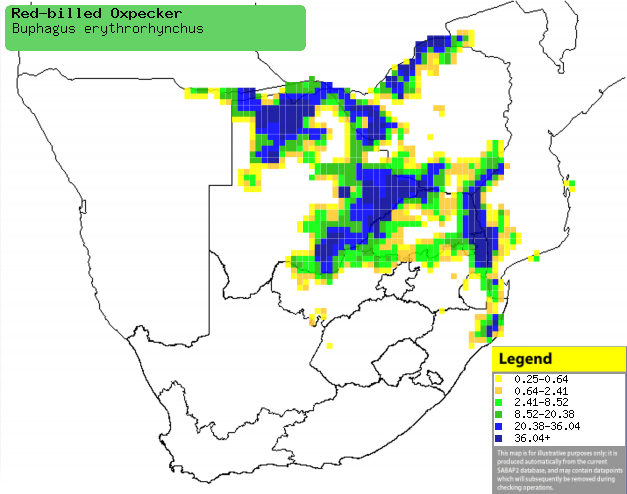|
Buphagus erythrorhynchus
(Red-billed oxpecker)
RooibekrenostervoŽl [Afrikaans]; Ihlalanyathi [Xhosa];
iHlalankomo, iHlalanyathi (terms also applied to Red-billed oxpecker) [Zulu];
Kamugcara (generic term for oxpecker; check: same name as Red-billed buffalo
weaver and African pygmy-goose) [Kwangali]; Tsande (generic name for oxpecker)
[Shona]; Yandhana [Tsonga]; Kala [Tswana]; Roodsnavel-ossepikker [Dutch];
Piqueboeuf ŗ bec rouge [French]; Rotschnabel-madenhacker [German];
Pica-bois-de-bico-vermelho [Portuguese]
Life
> Eukaryotes >
Opisthokonta
> Metazoa (animals) >
Bilateria >
Deuterostomia > Chordata >
Craniata > Vertebrata (vertebrates) > Gnathostomata (jawed
vertebrates) > Teleostomi (teleost fish) > Osteichthyes (bony fish) > Class:
Sarcopterygii (lobe-finned
fish) > Stegocephalia (terrestrial
vertebrates) > Tetrapoda
(four-legged vertebrates) > Reptiliomorpha > Amniota >
Reptilia (reptiles) >
Romeriida > Diapsida > Archosauromorpha > Archosauria >
Dinosauria
(dinosaurs) > Saurischia > Theropoda (bipedal predatory dinosaurs) >
Coelurosauria > Maniraptora > Aves
(birds) >
Order: Passeriformes > Family: Sturnidae
> Genus: Buphagus
For information about oxpeckers, see
birdinfo.co.za.
Distribution and habitat
Occurs in patches from Ethiopia and Somalia through Kenya,
Tanzania, Malawi and Zambia to southern Africa. Here it is locally common in the
open Savanna of the Caprivi Strip (Namibia), Botswana, Zimbabwe, southern
Mozambique and north-eastern South Africa.
|
 |
|
Distribution of Red-billed oxpecker in southern
Africa, based on statistical smoothing of the records from first SA Bird
Atlas Project (©
Animal Demography unit, University of Cape Town; smoothing by Birgit
Erni and Francesca Little). Colours range from dark blue (most common)
through to yellow (least common).
See here for the latest distribution from the SABAP2. |
Food
Although it sometimes hawks termite aerially and gleans
prey from vegetation, the bulk of its diet are ticks plucked from the skin of
large mammals, especially Plains zebra (Equus
quagga), rhinoceros (both
African species), Giraffe (Giraffa
camelopardis), horses, donkeys, goats and
bovines, specifically antelope, cattle and African buffalo (Syncerus
caffer). It may also collect blood and mucus from mammals with long
hair, often drinking blood from fresh wounds, thus keeping the area clean and
preventing infection or infestation by fly larvae (although this also leaves the
wound open and unhealed, which is disadvantageous to the mammal).
Breeding
- Monogamous, cooperative breeder, as the breeding pair are usually assisted
by up to 7 helpers who are usually unmated adults and juveniles from the
previous breeding season. Both courtship-feeding and the copulation that
follows take place on the back of a host mammal.
- It usually nests in a natural tree cavity or a hole in rock or a stone
wall, lining the interior with hair from its mammal hosts, dung, grass and
rootlets. It is sometimes kicked out of its nest by Burchell's starlings (Lamprotornis
australis) or Striped kingfishers (Halcyon
chelicuti).
- Egg-laying season is from October-March.
- It lays 2-5 eggs, which are incubated by both sexes for about for about
12-13 days.
- The chicks are fed by all members of the group, leaving the nest after
about 30 days and becoming fully independent roughly two months later.
Threats
Not threatened.
References
-
Hockey PAR, Dean WRJ and Ryan PG 2005. Roberts
- Birds of southern Africa, VIIth ed. The Trustees of the John Voelcker
Bird Book Fund, Cape Town.
|
